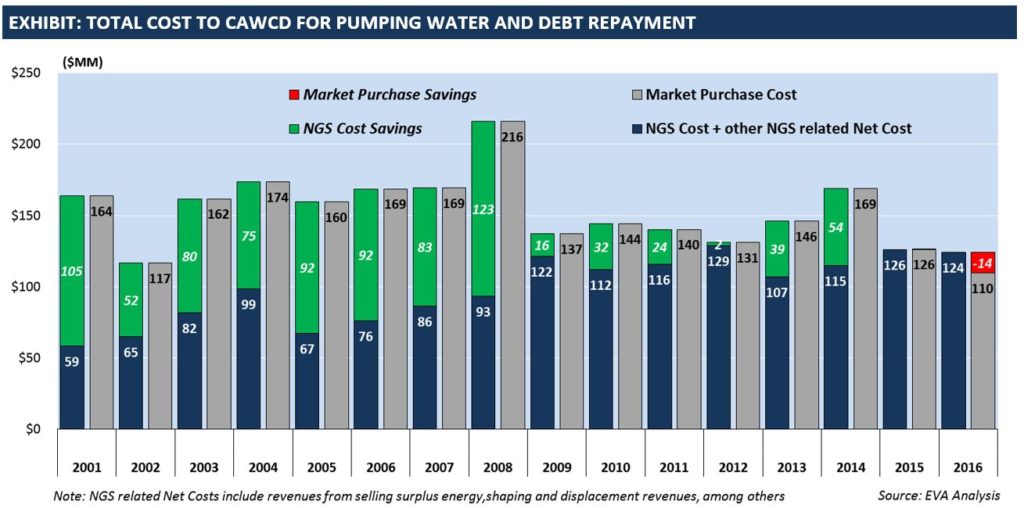The Central Arizona Water Conservation District (CAWCD) will realize a $370 million savings in power costs through 2030 and municipal and industrial customers will avoid a
30 percent increase in water charges over 10 years if the CAWCD continues purchasing power from the Navajo Generating Station (NGS) rather than the open market, a study released today by Energy Ventures Analysis (EVA) concludes.
The Navajo Generating Station has brought enormous economic benefits to the people of Arizona by delivering almost $900 million in power cost savings to the CAWCD since 2001 while driving down water rates to municipal and industrial customers as much as 45 percent during the period, the study found.
“The Navajo Generating Station will continue to be the low-cost power solution for the CAWCD well beyond 2019,” said Seth Schwartz, President of EVA. “The benefit is directly related to the amount of energy used: The more power purchased, the higher the savings in the years ahead.”
The Navajo Generating Station was authorized by Congress in the late 1960s to provide a stable, affordable power source for the Central Arizona Project (CAP) to move Colorado River water to the central and southern parts of the state for economic growth. The power plant and mine that fuels it were developed on tribal lands using tribally owned coal to bring jobs and revenues to the Navajo Nation and Hopi Tribe in northern Arizona.
Approximately 25 percent of the plant is held in trust for the U.S. Department of the Interior. The government’s share of electricity is divided to provide power for the CAP and generate revenues through the sale of surplus power to repay the U.S. Bureau of Reclamation for CAP construction. The CAWCD has a remaining debt obligation of $1.1 billion.
Because the Navajo Generating Station is the vehicle designed to make debt repayment possible, the CAWCD would need to identify a new revenue source in addition to paying up to $151 million in decommissioning costs if the plant is prematurely retired. Any potential savings of purchasing power from the open market will be more than offset by the loss of NGS-related revenue that is being used for debt repayment. If the plant is prematurely retired, full replacement capacity is estimated at nearly $2 billion.
“Allowing NGS to be retired 20 years early would result in an increased cost of power for the CAWCD, higher water rates to CAWCD customers and unnecessary capital expenses for constructing replacement capacity,” Phillip Graeter, senior manager at EVA and lead analyst of the study, said.
EVA believes the Navajo Generating Station will be the low-cost power source for the CAWCD based on its commodity price forecasts for the Desert Southwest (DSW) region, which indicate that the market conditions that drove power prices to historic-lows in 2016 were an anomaly and will not continue.
Over the last 16 years, the Navajo Generating Station has operated at a high capacity utilization rate averaging just under 85 percent, well above the U.S. coal fleet average of 62 percent. Because the plant is fueled by the nearby Kayenta Mine, the plant will continue to be one of the lowest cost and most competitive baseload resources in the DSW region, the report concludes. NGS plant owners have spent more than $1 billion over the last two decades on environmental compliance, resulting in one of the lowest emissions profiles of any coal-fueled power plant in the region.
The Navajo Generating Station and Kayenta Mine support 825 direct jobs and provide over 85 percent of the Hopi’s annual general fund budget and 22 percent of the Navajo’s annual general fund budget.
The EVA study, “Economic Benefit Analysis of the Navajo Generating Station for the Central Arizona Water Conservation District and Its Customers,” was commissioned by Peabody and is available here.
For more information about the report, please contact Phillip Graeter [email protected]
About EVA: Energy Ventures Analysis offers in-depth knowledge and expert energy consulting services to clients in the electric power, natural gas and oil, coal, environmental and renewable energy industries. EVA offers cutting-edge energy consulting services, including energy market fundamentals, economic analysis, and operational management that has led the firm to international recognition.
EVA recently has been recognized by Forbes magazine as a top energy consulting firm with outstanding energy consulting services and customer satisfaction.








